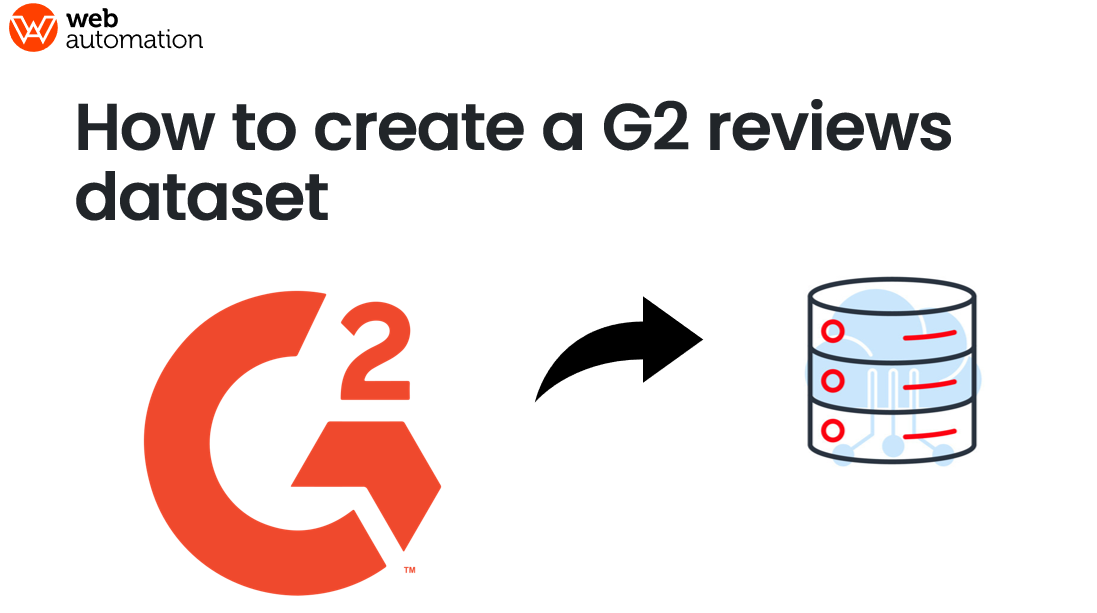
Learn how to create a comprehensive dataset of G2 reviews and products with this step-by-step guide.
By Admin @July, 8 2023

Are you interested in harnessing the insights from G2.com reviews and products to improve your business strategies? Building a comprehensive dataset can provide valuable information for market research, customer sentiment analysis, and competitor analysis. In this guide, we will walk you through the process of creating a dataset of G2 reviews and products, covering everything from data collection to analysis. Let's dive in and unlock the power of data!
Table of Contents
How to create a dataset of G2 reviews and products
1.1 Understanding the Importance of a G2 dataset
1.2 Defining your dataset objectives
1.3 Determining the scope and scale of your dataset
Collecting G2 reviews and products data
2.1 Utilizing web scraping techniques
2.2 Leveraging G2 APIs for data extraction
2.3 Ensuring data quality and accuracy
Preparing and cleaning the dataset
3.1 Structuring the dataset schema
3.2 Handling missing data and outliers
3.3 Standardizing data formats and variables
Analyzing and visualizing the dataset
4.1 Exploratory data analysis (EDA)
4.2 Generating descriptive statistics
4.3 Visualizing insights with charts and graphs
Applying natural language processing (NLP) techniques
5.1 Text Preprocessing and tokenization
5.2 Sentiment Analysis of reviews
5.3 Extracting key features and Entities
Building predictive models
6.1 Selecting appropriate machine learning algorithms
6.2 Training and testing the models
6.3 Evaluating model performance
Ensuring data privacy and compliance
7.1 Anonymizing sensitive information
7.2 Complying with data protection regulations
7.3 Safeguarding data against unauthorized access
FAQs
8.1 Can I use existing datasets instead of creating one?
8.2 How do I choose the right web scraping tool?
8.3 What are the best practices for data cleaning?
8.4 Is it necessary to have programming skills for dataset creation?
8.5 How can I handle scalability issues with a large dataset?
8.6 What are the ethical considerations of using user reviews?
To create a dataset of G2 reviews and products, follow these steps:
Understanding the importance of a G2 dataset
Before diving into the dataset creation process, it's essential to recognize the value of G2 reviews and product data. G2 is a prominent platform where users provide reviews and ratings for various software products. These reviews can offer insights into user experiences, preferences, and satisfaction levels. By building a dataset from G2 reviews and products, you can gain a competitive edge in your market and make data-driven decisions.
Defining your dataset objectives
Clearly define your objectives for creating a G2 dataset. Are you interested in understanding customer sentiment, identifying popular features, or benchmarking your product against competitors? Knowing your goals will help you determine the specific data elements to include in your dataset.
Determining the scope and scale of your dataset
Consider the scope and scale of your dataset. Are you focusing on specific product categories, industries, or time periods? Determine the volume of data you need to collect to ensure your dataset is representative and provides meaningful insights.
Utilizing web scraping techniques to extract data from G2.com
Web scraping is an effective method for gathering data from G2. There are various web scraping tools available that can help extract reviews, ratings, product information, and other relevant data. Choose a tool that suits your requirements and scrape the desired information from G2's website. Try out webautomation.io pre-built G2 web scraping tool , with this tool you do not need to learn how to code, all you have to do is enter the URLs and start scraping. Or you can use our ready-collected reviews dataset or the product dataset
Leveraging G2 APIs for data extraction
Another approach to collecting G2 reviews and products data is by leveraging G2's APIs. G2 provides APIs that allow developers to access review and product data programmatically. Familiarize yourself with G2's API documentation and use the appropriate endpoints to retrieve the desired data. G2 API documentation
Ensuring data quality and accuracy
Data quality is crucial for creating a reliable dataset. Implement data validation checks to identify and eliminate duplicate entries, inaccuracies, and irrelevant information. Perform data cleansing tasks, such as removing HTML tags, correcting typos, and normalizing text, to enhance the quality and consistency of your dataset.
Structuring the dataset schema
Design a well-defined schema for your dataset. Determine the attributes or variables you want to include, such as review text, product name, rating, date, and user demographics. Ensure consistency in the format and data types across all records.
Handling missing data and outliers
Address missing data and outliers in your dataset. Decide on appropriate strategies for handling missing values, such as imputation techniques or excluding records with incomplete information. Identify and analyze outliers to determine whether they should be removed or kept based on their impact on the analysis.
Standardizing data formats and variables
Standardize the formats of your dataset's variables to ensure consistency and comparability. For example, convert dates to a standardized format, normalize numerical values, and use consistent units of measurement. This step is crucial for accurate analysis and meaningful comparisons.
Exploratory data analysis (EDA)
Perform exploratory data analysis to gain insights into your dataset. Calculate summary statistics, identify patterns, and detect relationships between variables. Use statistical techniques and visualizations to uncover hidden trends, correlations, and outliers.
Generating descriptive statistics
Generate descriptive statistics to summarize the main characteristics of your dataset. Calculate measures such as mean, median, mode, and standard deviation for numerical variables. For categorical variables, analyze frequency distributions and calculate proportions or percentages.
Visualizing insights with charts and graphs
Present your dataset's insights visually using charts and graphs. Choose appropriate visualization techniques, such as bar charts, pie charts, histograms, or scatter plots, based on the nature of the data and the patterns you want to highlight. Visual representations make it easier to interpret and communicate the findings.
Text preprocessing and tokenization
Process the textual data in your dataset using NLP techniques. Clean the text by removing punctuation, stopwords, and irrelevant characters. Tokenize the text into individual words or phrases, allowing for further analysis and feature extraction.
Sentiment analysis of reviews
Conduct sentiment analysis on the review text to determine the overall sentiment expressed by users. Use pre-trained models or build your own sentiment classifier to classify reviews into positive, negative, or neutral categories. This analysis provides valuable insights into customer satisfaction and perception.
Natural Language Processing (NLP) libraries like NLTK (Natural Language Toolkit) and spaCy provide pre-built sentiment analysis capabilities.
Sentiment analysis APIs such as IBM Watson, Google Cloud Natural Language API, or Azure Text Analytics can be used for automated sentiment analysis.
Extracting key features and entities
Identify key features and entities mentioned in the reviews. Use techniques like named entity recognition (NER) to extract entities such as product names, company names, or specific attributes mentioned in the reviews. This information can help uncover important aspects that customers value or complain about.
Selecting appropriate machine learning algorithms
Based on your dataset objectives, select suitable machine learning algorithms for predictive modeling. Common algorithms include regression, classification, and clustering algorithms. Consider factors like the type of data, desired outputs, and available computing resources when choosing the algorithms.
Training and testing the models
Divide your dataset into training and testing sets for model development and evaluation. Train the selected machine learning models using the training set and fine-tune their parameters. Evaluate the models' performance using appropriate metrics, such as accuracy, precision, recall, or F1 score.
Evaluating model performance
Assess the performance of your predictive models and interpret the results. Compare the models based on their accuracy and other evaluation metrics. Consider using techniques like cross-validation to ensure the robustness and generalizability of the models.
Anonymizing sensitive information
If your dataset contains personally identifiable information (PII), take steps to anonymize or pseudonymize the data. This ensures compliance with data privacy regulations and protects the privacy of individuals.
Complying with data protection regulations
Be aware of and comply with relevant data protection regulations, such as the General Data Protection Regulation (GDPR) or the California Consumer Privacy Act (CCPA). Understand the legal requirements regarding data collection, storage, and usage to avoid potential legal issues.
Safeguarding data against unauthorized access
Implement appropriate security measures to protect your dataset against unauthorized access, breaches, or data leaks. Use encryption techniques, access controls, and secure storage systems to ensure the confidentiality and integrity of your data.
Can I use existing g2.com datasets instead of creating one?
Yes, you can use webautomation.io G2 Dataset which contains ~2.3Million reviews and 130,000 products.
How do I choose the right web scraping tool?
Choosing the right web scraping tool depends on factors such as the complexity of the website, the volume of data you need to extract, and your technical expertise. Consider factors like ease of use, scalability, and the tool's capabilities in handling dynamic websites. See our guide to choosing the best web scraping tool
What are the best practices for data cleaning?
When cleaning your dataset, it's important to handle missing data appropriately, remove duplicates, correct errors, and normalize the data format. Document your data cleaning procedures and maintain an audit trail to ensure transparency and reproducibility.
Is it necessary to have programming skills for dataset creation?
Having programming skills can be beneficial for dataset creation, especially when utilizing web scraping techniques or implementing data preprocessing steps. However, there are user-friendly tools and libraries available like webautomation.io that can simplify the process for non-programmers.
How can I handle scalability issues with a large dataset?
Scalability can be a challenge when dealing with large datasets. Consider using distributed computing frameworks or cloud-based solutions to handle the volume and processing requirements. Optimize your code and utilize parallel processing techniques to improve efficiency.
What are the ethical considerations of using user reviews?
When working with user reviews, it's crucial to respect user privacy and confidentiality. Ensure that any data you collect is anonymized and used in compliance with applicable privacy regulations. Obtain proper consent and make users aware of how their data will be used.
Conclusion
Creating a dataset of G2 reviews and products can be a powerful tool for gaining insights into user sentiment, market trends, and competitor analysis. By following the steps outlined in this guide, you can collect, clean, analyze, and utilize G2 data effectively. Remember to prioritize data quality, comply with privacy regulations, and use appropriate analytical techniques to derive meaningful insights from your dataset. Start harnessing the power of G2 reviews and products to drive informed decision-making in your business
At WebAutomation, We make the process of extracting web data quick and efficient so you can focus your resources on what’s truly important, using the data to achieve your business goals. In our marketplace, you can choose from hundreds of pre-built extractors for the world’s biggest websites.
These pre-built data extractors turn almost any website into a spreadsheet or API with just a few clicks. The best part? We build and maintain them for you!
Using WebAutomation lowers costs, requires no programming, enables you to get started quickly since we build the extractors for you, and means you’ll always have the help you need to keep your extractor running since we handle all the backend security and maintenance.
Web Scraping has never been this easy.